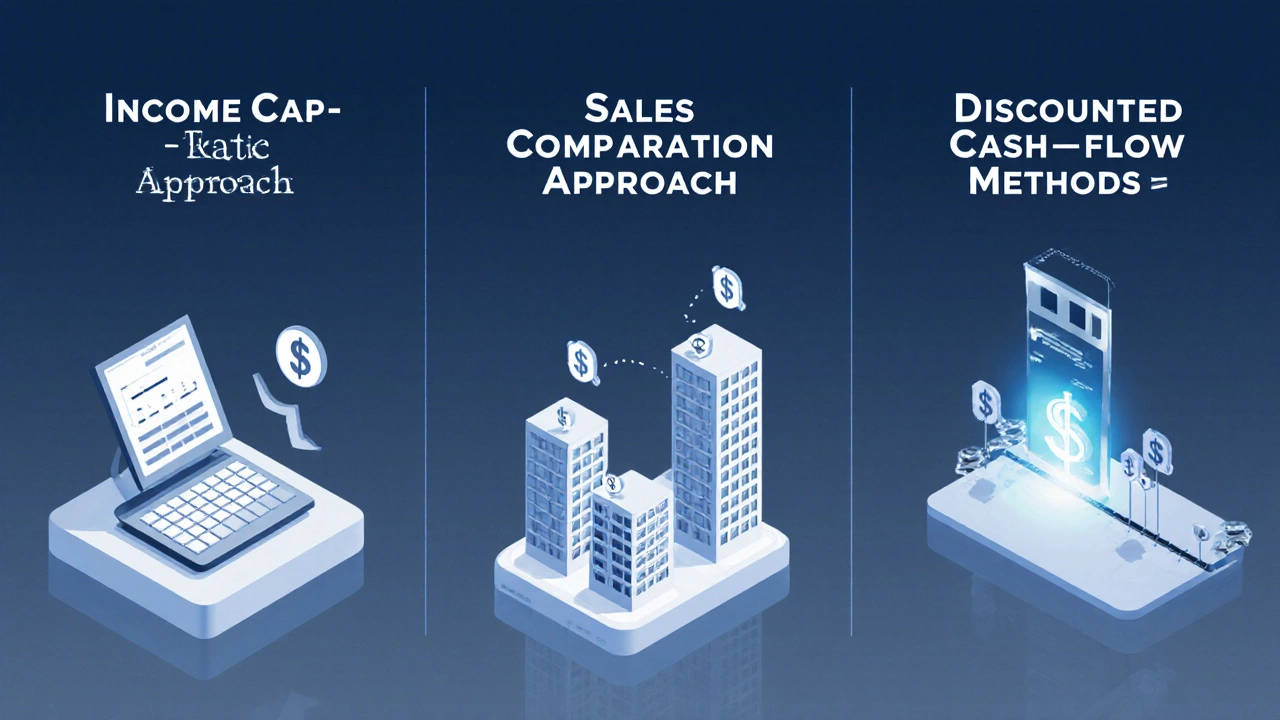Commercial Property Value Calculator
This calculator uses the Income Approach method to estimate commercial property value based on net operating income and market cap rates.
Valuation Calculator
When you’re trying to figure out Commercial Property Value is the estimated monetary worth of a commercial real‑estate asset based on income potential, market data, and future cash‑flow projections, the process can feel like decoding a puzzle. Whether you’re a first‑time investor, a broker, or a property owner planning a sale, a reliable valuation helps you set realistic expectations, negotiate confidently, and avoid costly missteps.
Key Takeaways
- Three main valuation methods dominate: Income (cap‑rate) approach, Sales comparison approach, and Discounted cash‑flow (DCF) model.
- Accurate input data-net operating income, vacancy rates, market cap rates, and comparable sales-makes the difference between a solid estimate and a wild guess.
- Use a spreadsheet or a dedicated calculator to run the numbers; most errors come from manual arithmetic.
- Cross‑check results with at least two methods to spot outliers.
- Common pitfalls include ignoring operating expenses, using outdated cap rates, and overlooking future rent escalations.
Understanding the Basics
Before diving into formulas, it helps to know the building blocks that feed every valuation model.
Net Operating Income (NOI) is the property’s total revenue minus all operating expenses, but before debt service and taxes. It captures how much cash the asset truly generates each year.
Capitalization Rate (Cap Rate) is the ratio of NOI to the property’s market price, reflecting the return investors expect for a given risk level. Market cap rates vary by location, property type, and economic climate.
Comparable Sales (Comps) is a set of recently sold, similar properties used to gauge market sentiment and price trends. The more recent and similar the comps, the more reliable the estimate.
Discounted Cash Flow (DCF) is a method that projects future cash flows over a holding period and discounts them back to present value using a chosen discount rate. DCF captures the time value of money and future rent growth.
Vacancy Rate is the percentage of rentable space that is expected to be unoccupied during a typical year. A realistic vacancy assumption prevents over‑optimistic income forecasts.
Method 1 - Income (Cap‑Rate) Approach
The income approach is the workhorse for most office, retail, and industrial assets. It boils down to a single, easy‑to‑remember formula:
Value = NOI ÷ Cap Rate
Step‑by‑step:
- Calculate Gross Rental Income: multiply each lease’s annual rent by its square footage, then sum.
- Adjust for Vacancy: multiply Gross Rental Income by (1 - Vacancy Rate).
- Subtract Operating Expenses (property management, insurance, maintenance, taxes) to arrive at NOI.
- Research the current market cap rate for the asset class and sub‑market. Sources include local broker reports, CoStar, CBRE market surveys, and recent transaction data.
- Divide NOI by the cap rate (expressed as a decimal) to get the estimated value.
Example: A 10,000 sq ft office building generates $2,500,000 in gross rent. The local vacancy rate is 8 % and operating expenses total $450,000. The market cap rate for similar office space is 6.5 %.
- Effective Gross Income = $2,500,000 × (1 - 0.08) = $2,300,000
- NOI = $2,300,000 - $450,000 = $1,850,000
- Value = $1,850,000 ÷ 0.065 ≈ $28,461,538
This quick calculation gives you a solid baseline.
Method 2 - Sales Comparison Approach
The sales comparison method leans on market reality. It answers the question: "What have buyers paid for similar properties recently?" The steps are:
- Gather at least three comparable sales that match the subject property in size, age, location, and use.
- Adjust each comp’s sale price for differences. Typical adjustments cover:
- Square‑footage variance (price per sq ft)
- Lease terms (long‑term vs. triple‑net)
- Condition and recent upgrades
- Parking ratios or loading dock availability
- Derive an average adjusted price per square foot.
- Multiply the subject’s usable square footage by the average price per square foot to estimate value.
Example: Three recent sales in the same Melbourne CBD corridor show adjusted prices of $2,800, $3,100, and $2,950 per square foot. The average is $2,950. For a 10,000 sq ft building, the estimated value equals $29,500,000.
The strength of this method lies in its market‑driven nature, but it can be limited when few recent sales exist.

Method 3 - Discounted Cash Flow (DCF) Model
DCF is the most detailed technique. It accounts for rent escalations, capital expenditures, and the investor’s required return. The workflow:
- Project annual net cash flows for a chosen holding period (typically 5‑10 years). Include rent growth assumptions, expense inflation, and scheduled capital improvements.
- Select a discount rate (often the investor’s hurdle rate or Weighted Average Cost of Capital).
- Discount each year’s cash flow back to present value using the formula:
PV = CashFlow ÷ (1 + DiscountRate)^Year
- Sum the present values of all projected cash flows.
- Estimate a terminal value at the end of the holding period, typically using the cap‑rate method on the Year N NOI, then discount it back to present.
- Add the discounted terminal value to the sum of discounted cash flows for the total DCF valuation.
Example: Assume the same 10,000 sq ft office building generates an initial NOI of $1.85 million, grows 2 % per year, and the investor uses a 9 % discount rate. After ten years, the terminal value is calculated using a 6.5 % cap rate on the Year 10 NOI. Running the numbers in a spreadsheet yields a DCF value of roughly $27.9 million.
DCF often produces a lower or higher figure than the simple cap‑rate method, depending on growth assumptions and the chosen discount rate.
Data Sources & Tools
Accurate inputs are worth the legwork. Here are reliable sources you can tap:
- CoStar and Real Capital Analytics for market cap rates, vacancy trends, and recent comps.
- State revenue office property tax records for operating expense baselines.
- Local council zoning maps to confirm allowable uses and development potential.
- Australian Bureau of Statistics (ABS) for inflation and population growth data that affect demand.
- Spreadsheet software (Excel, Google Sheets) or dedicated valuation calculators like PropInvest or Argus.
Most seasoned brokers keep a master spreadsheet that pulls data from these feeds, reducing duplication.
Common Pitfalls to Avoid
Even experienced valuers stumble when they overlook small details.
- Ignoring operating expense spikes: maintenance, insurance premiums, and property taxes can jump dramatically after a major renovation.
- Using stale cap‑rate data: market conditions shift quickly, especially after policy changes or interest‑rate moves.
- Assuming 100 % occupancy: the vacancy rate should reflect local market averages, not an optimistic best‑case scenario.
- Forgetting future rent escalations: many commercial leases include CPI‑linked increases that add significant upside.
- Over‑relying on a single method: cross‑checking with at least two approaches catches outliers.

Step‑by‑Step Calculator Example
Let’s walk through a full valuation using a simple Excel template.
- Enter basic property data: size (10,000 sq ft), current rent per sq ft ($250), and lease term remaining (5 years).
- Set vacancy rate at 8 % and operating expense ratio at 25 % of gross income.
- Excel computes Gross Income = Size × Rent = $2,500,000.
- Effective Gross Income = $2,500,000 × (1‑0.08) = $2,300,000.
- Operating Expenses = $2,300,000 × 0.25 = $575,000.
- NOI = $2,300,000 - $575,000 = $1,725,000.
- Insert market cap rate (6.5 %): Value = $1,725,000 ÷ 0.065 ≈ $26,538,462.
- Switch to the DCF tab: project 2 % rent growth, 3 % expense inflation, discount rate 9 %.
- Excel outputs a discounted cash‑flow value of $27,200,000.
- Compare the two results: the income approach is $26.5 M, DCF is $27.2 M - the spread is within a reasonable range, suggesting the assumptions are sound.
The final figure you present to a buyer or lender can be a weighted average of the methods, or you can explain the range and let the market decide.
Putting It All Together
Calculating commercial property value isn’t a magic trick; it’s a disciplined process that blends market data, financial math, and realistic assumptions. Start with clean numbers, run at least two valuation methods, and reconcile any big gaps. When you’re comfortable with the inputs, the output becomes a reliable tool for negotiations, financing, and strategic planning.
Frequently Asked Questions
What is the most common way to value a retail space?
Retail properties are typically valued using the income approach, where the net operating income is divided by the market cap rate for that sub‑market. Sales comparables are also used when enough recent transactions exist.
How often should I update the cap rate in my valuation?
Cap rates can shift quarterly, especially after major interest‑rate changes or economic news. Review them at least every six months for active listings.
Can I use the same discount rate for all commercial assets?
Not advisable. Different asset classes carry different risk profiles. Offices may warrant a lower discount rate than industrial warehouses, reflecting their relative stability.
What role do future rent escalations play in DCF?
Escalations add cash flow each year, boosting the present value. Ignoring them can undervalue the property by millions, especially for long‑term leases with built‑in CPI adjustments.
Are there free tools for a quick commercial valuation?
Several real‑estate websites offer basic calculators that let you input rent, expenses, and cap rate. They’re fine for rough checks, but for a sale you’ll want a spreadsheet or professional software for accuracy.
